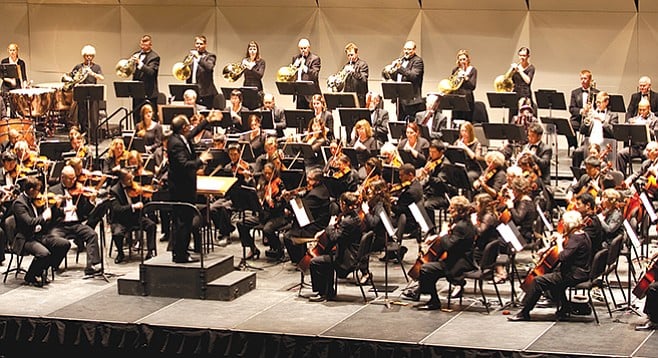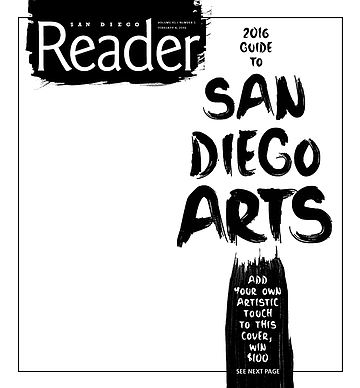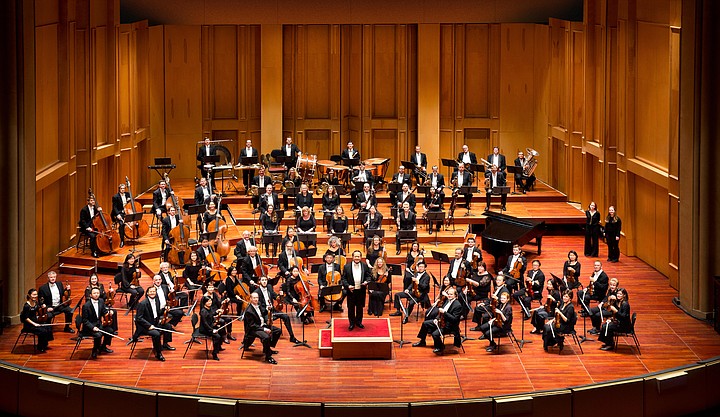 Facebook
Facebook
 X
X
 Instagram
Instagram
 TikTok
TikTok
 Youtube
Youtube


Classical music in San Diego is always in transition. Organizations have come and organizations have gone. General directors and conductors have retired, moved on, or shuffled away in disgrace. Attendance has been up and attendance has been down. The one thing that remains steady in the culture of classical music is the music itself. I’ve been to concerts of institutions whose budgets are measured in the millions and others with budgets measured five dollars at a time, yet both have the same opportunity to present masterpieces. I’ve been to concerts where world-class celebrities have failed and unknown amateurs have triumphed. Classical music is always and forever about the music and then the performer. Some performers make music work for them and the music becomes the servant of their success. The results might be spectacular but there is a gaping hole where the heart should be. More and more I’ve seen the opposite. I’ve seen musicians serving the music before they serve themselves. This act of submission occurs at every level, from musical royalty to musical neophytes. Service is the heart of music. This is not something I knew. It is something that has been taught to me by the musicians of San Diego.
San Diego Opera brings world-class singers to the stage at San Diego’s Civic Theater. The company has been a mainstay of the performing-arts scene for 50 years. In 2014, the company went through a dramatic restructuring and is moving forward with a vision of bringing opera to a wider audience. Opera is the crown jewel of live theater and maintains a strict policy of acoustic singing. Singers perform without microphones or amplification of any type, which gives the sound the added dimensions of depth and location. Performances can be in Italian, German, French, Russian, Czech, Spanish, and English. All performances have English translations projected above the stage.

Every member of the San Diego Symphony is a world-class talent. Besides immense natural talent, these musicians have put in tens of thousands of hours practicing their art. As with the opera, the symphony is also a purely acoustic experience with no electronic amplification except on the rare occasion when La Mesa’s own Dave Mustaine, of the band Megadeth, plays electric guitar with the orchestra. The San Diego Symphony presents music from around the world with compositions from Europe, North America, and Asia. The selections also draw off of a 400-year-old tradition of Western orchestral music.
The La Jolla Symphony and Chorus is a group of amateur musicians associated with the University of California San Diego. The organization specializes in large-scale compositions for orchestra and chorus, such as Berlioz’s Requiem and contemporary music such as John Luther Adams’s Become Ocean. Their performance venue is Mandeville Auditorium, which is a medium-sized theater. The combination of a huge orchestra and chorus with the moderate size of the venue makes for an overwhelming sonic experience. The La Jolla Symphony has a tradition for using local soloists and also has a young-artist competition that provides monetary prizes for up-and-coming musicians.
The Point Loma Opera Theater is the most prolific opera company in San Diego County, putting on as many as six productions per year. The company was founded in 2009 by students at Point Loma Nazarene University when the institution canceled the opera-workshop course. The productions are performed in the original languages, with translations provided above or next to the stage. The organization is run, from top to bottom, by students. They raise the funds, hire the director, hire the conductor, find costumes, build sets, and cast the singers.
Art of Elan is a chamber-music organization that partners with the LUX Art Institute in Encinitas as a venue along with the Museum of Art in Balboa Park and the Glashaus in Barrio Logan. Art of Elan is a progressive organization that has successfully collaborated with not just museums and galleries but also the Malcolm X Library and A Reason to Survive (ARTS) in National City. The Formosa Quartet is currently the ensemble in residence at Art of Elan. The residency includes performances in San Diego County and the creation of new compositions by San Diego composers such as UCSD’s Lei Liang. The Formosa Quartet performs internationally in North and South America, Europe, Asia, and Australia.
The Grossmont Symphony Orchestra and Master Chorale has several different ensembles that create its 2015–’16 season of 11 concerts in East County. Besides the orchestra and chorus, there are wind and string quintets that perform as part of the musical offerings for the east county. The organization is an extension of the music program at Grossmont College, with members of the community joining the staff and students of the college. The range of music that is performed over the course of the current season is as diverse as any musical institution with pieces from the 17th to 20th centuries.
The La Jolla Music Society was established in 1941 and brings a vast array of artists to San Diego. The society is in the process of constructing the Conrad, a $65 million project in the heart of La Jolla that is expected to become operational in early 2018. For decades, the La Jolla Music Society has been using Sherwood Auditorium, the Civic Theater, and Symphony Hall as the primary venues for their visiting artists. There is no official orchestra or chamber ensemble associated with the La Jolla Music Society. During their SummerFest, artists from around the world come together and create unique collaborations. In order to create a season of music outside SummerFest, the society invites soloists such as Itzhak Perlman to complete orchestras such as the Vienna Philharmonic.
In the early weeks of June, the Mainly Mozart Festival Orchestra assembles at the Balboa Theatre downtown. The orchestra draws its members from orchestras across the United States. While it is together it could be argued that this orchestra is the most prestigious group of musicians in the world, and if that argument should fail then we can safely say they are really, really, good. The festival orchestra usually performs five unique concerts, with smaller groups of musicians breaking off to perform chamber music in venues such as Balboa Park’s Timken Museum. Throughout the year Mainly Mozart produces chamber concerts across the county and also dabbles in neuroscience with concerts that explore music and the brain.



Classical music in San Diego is always in transition. Organizations have come and organizations have gone. General directors and conductors have retired, moved on, or shuffled away in disgrace. Attendance has been up and attendance has been down. The one thing that remains steady in the culture of classical music is the music itself. I’ve been to concerts of institutions whose budgets are measured in the millions and others with budgets measured five dollars at a time, yet both have the same opportunity to present masterpieces. I’ve been to concerts where world-class celebrities have failed and unknown amateurs have triumphed. Classical music is always and forever about the music and then the performer. Some performers make music work for them and the music becomes the servant of their success. The results might be spectacular but there is a gaping hole where the heart should be. More and more I’ve seen the opposite. I’ve seen musicians serving the music before they serve themselves. This act of submission occurs at every level, from musical royalty to musical neophytes. Service is the heart of music. This is not something I knew. It is something that has been taught to me by the musicians of San Diego.
San Diego Opera brings world-class singers to the stage at San Diego’s Civic Theater. The company has been a mainstay of the performing-arts scene for 50 years. In 2014, the company went through a dramatic restructuring and is moving forward with a vision of bringing opera to a wider audience. Opera is the crown jewel of live theater and maintains a strict policy of acoustic singing. Singers perform without microphones or amplification of any type, which gives the sound the added dimensions of depth and location. Performances can be in Italian, German, French, Russian, Czech, Spanish, and English. All performances have English translations projected above the stage.

Every member of the San Diego Symphony is a world-class talent. Besides immense natural talent, these musicians have put in tens of thousands of hours practicing their art. As with the opera, the symphony is also a purely acoustic experience with no electronic amplification except on the rare occasion when La Mesa’s own Dave Mustaine, of the band Megadeth, plays electric guitar with the orchestra. The San Diego Symphony presents music from around the world with compositions from Europe, North America, and Asia. The selections also draw off of a 400-year-old tradition of Western orchestral music.
The La Jolla Symphony and Chorus is a group of amateur musicians associated with the University of California San Diego. The organization specializes in large-scale compositions for orchestra and chorus, such as Berlioz’s Requiem and contemporary music such as John Luther Adams’s Become Ocean. Their performance venue is Mandeville Auditorium, which is a medium-sized theater. The combination of a huge orchestra and chorus with the moderate size of the venue makes for an overwhelming sonic experience. The La Jolla Symphony has a tradition for using local soloists and also has a young-artist competition that provides monetary prizes for up-and-coming musicians.
The Point Loma Opera Theater is the most prolific opera company in San Diego County, putting on as many as six productions per year. The company was founded in 2009 by students at Point Loma Nazarene University when the institution canceled the opera-workshop course. The productions are performed in the original languages, with translations provided above or next to the stage. The organization is run, from top to bottom, by students. They raise the funds, hire the director, hire the conductor, find costumes, build sets, and cast the singers.
Art of Elan is a chamber-music organization that partners with the LUX Art Institute in Encinitas as a venue along with the Museum of Art in Balboa Park and the Glashaus in Barrio Logan. Art of Elan is a progressive organization that has successfully collaborated with not just museums and galleries but also the Malcolm X Library and A Reason to Survive (ARTS) in National City. The Formosa Quartet is currently the ensemble in residence at Art of Elan. The residency includes performances in San Diego County and the creation of new compositions by San Diego composers such as UCSD’s Lei Liang. The Formosa Quartet performs internationally in North and South America, Europe, Asia, and Australia.
The Grossmont Symphony Orchestra and Master Chorale has several different ensembles that create its 2015–’16 season of 11 concerts in East County. Besides the orchestra and chorus, there are wind and string quintets that perform as part of the musical offerings for the east county. The organization is an extension of the music program at Grossmont College, with members of the community joining the staff and students of the college. The range of music that is performed over the course of the current season is as diverse as any musical institution with pieces from the 17th to 20th centuries.
The La Jolla Music Society was established in 1941 and brings a vast array of artists to San Diego. The society is in the process of constructing the Conrad, a $65 million project in the heart of La Jolla that is expected to become operational in early 2018. For decades, the La Jolla Music Society has been using Sherwood Auditorium, the Civic Theater, and Symphony Hall as the primary venues for their visiting artists. There is no official orchestra or chamber ensemble associated with the La Jolla Music Society. During their SummerFest, artists from around the world come together and create unique collaborations. In order to create a season of music outside SummerFest, the society invites soloists such as Itzhak Perlman to complete orchestras such as the Vienna Philharmonic.
In the early weeks of June, the Mainly Mozart Festival Orchestra assembles at the Balboa Theatre downtown. The orchestra draws its members from orchestras across the United States. While it is together it could be argued that this orchestra is the most prestigious group of musicians in the world, and if that argument should fail then we can safely say they are really, really, good. The festival orchestra usually performs five unique concerts, with smaller groups of musicians breaking off to perform chamber music in venues such as Balboa Park’s Timken Museum. Throughout the year Mainly Mozart produces chamber concerts across the county and also dabbles in neuroscience with concerts that explore music and the brain.
Comments